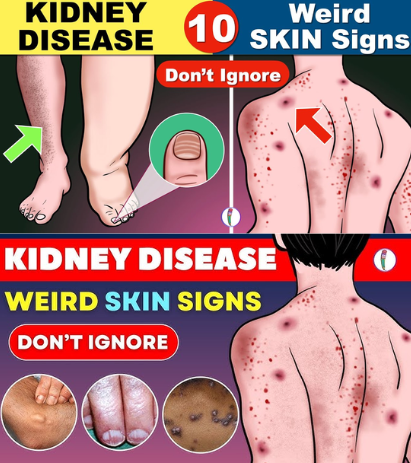
Your skin can tell you a lot about your overall health, and in the case of kidney failure (also known as renal failure), it might be one of the first places you notice that something isn’t right. While the kidneys work quietly behind the scenes to filter waste, balance fluids, and control blood pressure, problems with kidney function can eventually appear on the surface—your skin.
In this article, we’ll explore how chronic kidney disease (CKD) and kidney failure can manifest through various skin symptoms. Recognizing these signs early may help you seek proper medical care before the condition worsens.
Why the Skin Is Affected by Kidney Problems
The kidneys play a vital role in removing toxins and waste from your blood. When they begin to fail, waste products accumulate in the body, leading to a condition called uremia. These toxins can affect multiple systems—including your skin.
Additionally, kidney failure can disrupt calcium and phosphate levels, affect hormone balance, and compromise blood flow—all of which contribute to skin changes. In patients with end-stage renal disease, skin symptoms can be quite noticeable and even painful.
Let’s take a closer look at the most common skin issues associated with kidney failure.
1. Extremely Dry Skin (Xerosis)
Dry, flaky skin is one of the most frequent complaints among people with kidney failure. The skin may feel tight, rough, or scaly—especially on the arms, legs, and back.
Why it happens:
Kidneys are responsible for maintaining proper hydration in the body. When they don’t function correctly, water regulation suffers, leading to skin dehydration. In some cases, dialysis can worsen this dryness, especially if the patient is fluid-restricted.
What to do:
Use gentle, fragrance-free moisturizers multiple times a day. Avoid hot showers and harsh soaps that strip natural oils.
2. Itching (Pruritus)
Persistent itching without a visible rash is another common sign of kidney failure. This condition, called uremic pruritus, affects about 40–50% of people on dialysis. The itching can be localized or affect the entire body, and it often worsens at night.
Why it happens:
While the exact cause isn’t fully understood, itching is believed to result from the buildup of waste products, imbalances in calcium and phosphate, or inflammation caused by dialysis.
What to do:
Moisturizing regularly, avoiding heat, and using prescribed medications like antihistamines or gabapentin may help. Speak with a doctor to rule out other causes and manage symptoms properly.
3. Discoloration or Pallor
Kidney failure can cause your skin to look unusually pale or even grayish in color. Some people also develop a yellowish hue, especially in later stages of the disease.
Why it happens:
Anemia is common in kidney failure because damaged kidneys produce less erythropoietin—a hormone needed to make red blood cells. Less oxygen-carrying capacity in the blood results in pallor. The grayish tint may also come from retained toxins.
What to do:
If you notice your skin tone changing, it’s important to have your kidney function and blood counts checked by a healthcare provider.
Video : Skin signs of Kidney Disease | Chronic Kidney Disease | Kidney Failure Symptoms | CKD
4. Bruising and Thin Skin
People with kidney failure may notice that their skin bruises more easily or appears thinner and more fragile than normal.
Why it happens:
Kidney dysfunction can affect the blood’s ability to clot, and certain medications or vitamin deficiencies (such as vitamin K or C) related to CKD can also contribute to easy bruising.
What to do:
Avoid trauma to the skin, and let your doctor know if bruising happens frequently or without clear cause.
5. Skin Rash and Lesions
Some individuals with severe kidney problems develop rashes or ulcer-like lesions, especially in cases of calciphylaxis—a rare but serious condition where calcium accumulates in the blood vessels of the skin, leading to tissue damage.
Why it happens:
In CKD, calcium and phosphate levels can become unbalanced, leading to deposits in soft tissue and small blood vessels. This restricts blood flow and results in painful, sometimes deadly skin ulcers.
What to do:
Calciphylaxis is a medical emergency. If you notice black, necrotic-looking sores or unusual skin breakdown, seek immediate attention.
6. Nail and Hair Changes
Though technically not the skin, your nails and hair are considered appendages of the skin and can reflect internal health problems.
Common nail signs of kidney disease include:
- Half-and-half nails: The bottom half of the nail appears pale or white, while the top is darker.
- Beau’s lines: Indentations or ridges across the nail.
- Brittle nails or ridging
Hair may become dry, brittle, or thin, and some individuals may experience hair loss.
What to do:
These changes are often cosmetic but can be early indicators of systemic issues. Proper nutrition, hydration, and treatment of the underlying kidney condition can improve the appearance of nails and hair.
7. Metallic Taste and Bad Breath (Ammonia Smell)
Again, while not a skin symptom, many people with kidney failure experience changes in taste and breath odor due to uremia.
Why it matters:
This symptom, alongside dry or flaky lips and mouth sores, may also affect how you care for your skin—especially if you avoid eating or drinking due to taste changes, which could worsen dehydration and skin dryness.
How to Care for Your Skin with Kidney Disease
Skin care for individuals with kidney problems should be gentle and consistent. Here are some helpful tips:
- Use moisturizers with ceramides, urea, or glycerin to hydrate the skin.
- Avoid scratching—trim nails and wear gloves if itching is severe.
- Use lukewarm water for bathing and keep showers short.
- Pat dry instead of rubbing your skin after bathing.
- Wear loose, breathable clothing to avoid skin irritation.
- Use sunscreen daily, as kidney disease can make your skin more sensitive to UV rays.
When to Seek Medical Help
If you’re noticing multiple skin-related symptoms—especially when paired with fatigue, swelling, changes in urination, or nausea—it’s time to see a doctor. Early diagnosis of kidney problems can prevent serious complications.
Blood tests (such as serum creatinine, eGFR, and blood urea nitrogen) and urine tests can provide critical insights into kidney function. Your skin may be trying to alert you before other symptoms become severe.
Video : Doctor Explains 7 Skin Signs of Chronic Kidney Disease (CKD) – Never Ignore These Symptoms
Final Thoughts
Kidney failure doesn’t just affect what’s inside—it often shows up on the outside too. From persistent itching to unusual skin discoloration or lesions, your skin can reveal much about your internal health. While many of these symptoms may seem harmless at first, ignoring them could delay diagnosis and treatment of a serious condition.
By paying close attention to your skin and overall wellness, and by working closely with your healthcare provider, you can manage kidney-related skin problems more effectively—and improve your quality of life in the process.


